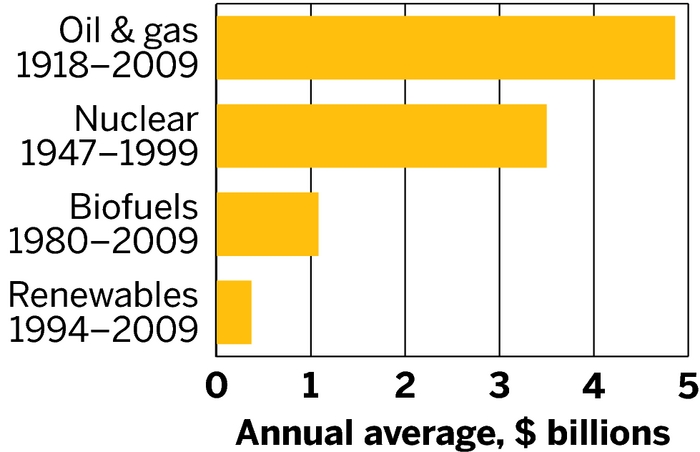mousepad wrote:Renewables are about 10% of total power use currently. Nuclear which is not renewable (but low carbon) are about 5%.
Germany, which generates about 50% of it's electricity with renewables still only to manages to achieve less than 20% of its total energy consumption to be renewable. Not to mention that this experiment only works because they can import shortfall electricity from either France's nuclear or eastern european coal plants while exporting their overproduction to switzerland.
Power generation refers to electricity generation. Energy is electricity + heat + transportation. Those are 2 different categories.
mousepad wrote:You love your forecasts, don't you?
It's simple math. As of today, renewables have already passed the largest source of fossil fuel capacity: coal. Renewables are adding 300 GW a year of new capacity. At that rate, it will take 3 years before renewables pass all of fossil fuel capacity combined. Even if renewables suddenly have a series of really bad years and their capacity additions slow by half, that simply pushes the number of years it will take renewables to overtake fossil fuel capacity from 3 years to 6.
C8 wrote:Not so
Again, power generation refers to electricity generation. Total primary energy consumption is electricity consumption + heat + transportation.
C8 wrote:I am posting this chart of India's energy consumption because it is so very interesting to the debate. India gets massive amounts of sunshine and really should be well supplied by solar power by this time given how long cheaper solar cells have been in existence. India's government is not very wealthy and doesn't really give much of a subsidy to the solar industry. As such, India makes it perfect example of whether or not solar can survive on its own with lots of sunshine and very little in the way of subsidies. As you can see, India is not very solar. Much of India's renewable energy generation is biomass, which is essentially burning waste or forest- that is not something that is very scalable.
India has massive amounts of fossil fuel subsidies.
Key Findings
Since 2017, government support for fossil fuels increased by 65 per cent while support for renewables declined by 35 per cent. India’s subsidies to oil, gas and coal are seven times more than the value of subsidies to renewables and electric vehicles.
Mapping India’s Energy Subsidies 2020C8 wrote:Renewable energy is like a 40 year old child who keeps asking dad for rent because someday he will become wealthy. If we were having this debate in 2005 then there might be causes for optimism. But as it is now 2022, renewable energy has had a very long time sucking at the government tit be able to prove itself and it hasn't. No amount of data will change anything about this- the only thing that really matters now is actual performance.
When coal was introduced, there was no need for subsidies as it was clearly cheaper and better. Oil came and again, there was no need for subsidies. When nuclear came (after the technology was developed) there was no need for subsidies. The endless time that renewable energy needs subsidies is a clear warning sign. This stuff will not scale up anywhere near what we need for the future. The more you make of something, the higher the price goes if some of their ingredients necessary are rare. Whereas most businesses have an economy of scale, due to the rarity of many of the materials in a renewable business there are actually diseconomies of scale.
Incorrect. Both fossil fuels and nuclear have been sucking on the tit of government subsidies for decades. And spending on subsidies for fossil fuels and nuclear have been much larger than renewables.
U.S. government subsidies for energy are as old as the nation. Pfund and coauthor Ben Healey trace U.S. government energy incentives back to 1789. Using government documents, academic papers, and a mix of other data and reports, Pfund and Healey offer a historical perspective on today’s debate over energy subsidies. Their study finds a paucity of government support for renewable energy sources compared with past government investment in coal, gas, oil, or nuclear energy sources, which helped the country transition to new energy technologies and infrastructures.
Their study, “What Would Jefferson Do? The Historical Role of Federal Subsidies in Shaping America’s Energy Future,” also finds that federal support of renewable energy falls short of the aid the federal government has given to oil, gas, coal, and nuclear energy when they were new. In fact, they say, backing for renewable energy is trivial in size.
Coal, Pfund notes, benefits from a host of centuries-old programs that signal a rich history of aid, which is intertwined with the development of the nation. Pfund and Healey also found that some types of government support—particularly tax breaks—don’t go away because they are embedded in the tax code. “These subsidies have been huge, and they are the gift that keeps on giving for many energy sources,” Pfund says. Temporary tax incentives intended to spur exploration or development of fossil fuels have become a permanent part of the country’s economic system, Pfund notes. For example, coal companies can still take advantage of a measure passed in 1950 that originally allowed them to “temporarily” avoid a tax increase enacted to help fund the Korean War, the study says. Similarly, several measures to aid oil companies passed in the early 1900s remain of key importance to the industry. Nuclear power plants also benefit strongly from subsidies.

Oil and gas lead in historical average of annual subsidies.
Long History Of U.S. Energy Subsidiestheluckycountry wrote:kublikhan wrote:Renewables now generate more than a quarter of the planet's power. This is not some trick of mathematics, that's the facts.
Quite true, Germany for one buys woodchip from the US to burn in their generating plants. Very renewable lol. You're so gullible kublikhan
Incorrect. Germany is a net exporter of wood pellets. US imports mostly go to the UK. In Germany, Wind and Solar PV alone make up more than a quarter of Germany's electricity generation. Fossil fuels have fallen to less than half.
It all started back in 2014 at the latest: North American groups began charging that the EU’s policy of co-firing wood pellets in coal power stations should be discontinued because more and more forests in the United States in particular were being cut down. As I pointed out 18 months ago, however, Germany is clearly not the problem. The country remains a net exporter of wood pellets, which it largely makes from waste wood sourced locally. Only 0.07% of German electricity comes from fresh timber, most of it in cogeneration units that mainly produce heat—electricity is a byproduct that increases the overall efficiency of the process.
Germany does not import significant quantities of wood pellets from the United States. The UK is the main culprit with its Drax power plant.
The pellet debate gets weirdThe oil barrel is half-full.








